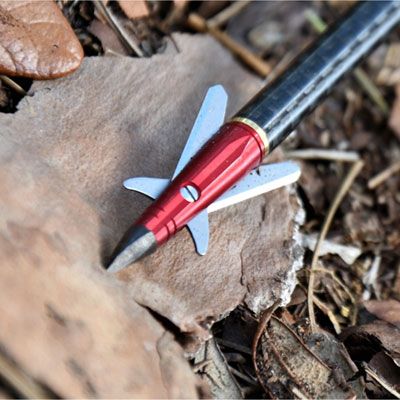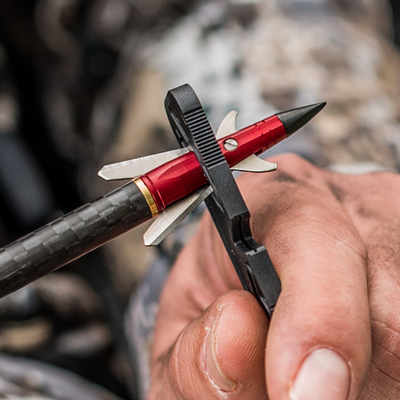100 vs 125 grain broadheads for deer – When it comes to choosing the right broadhead for deer hunting, there are two main weight options to consider: 100 grains and 125 grains. Both have their own advantages and disadvantages, so it’s important to understand the differences before making a decision.
In this article, we’ll compare 100 vs 125 grain broadheads in terms of ballistic performance, cutting diameter and penetration, broadhead design and construction, game size and shot placement, and field performance and hunting applications. By the end, you’ll have all the information you need to make an informed decision about which broadhead is right for you.
Ballistic Performance


When comparing 100 and 125 grain broadheads, the trajectory and velocity play a significant role in determining their effectiveness. Generally, heavier broadheads exhibit a flatter trajectory due to their increased momentum, making them more accurate at longer distances. However, they tend to have a slightly lower velocity compared to lighter broadheads.
In terms of penetration and energy retention, heavier broadheads typically offer better performance. Their increased mass provides more kinetic energy, allowing them to penetrate deeper into the target. This can be particularly advantageous for hunting larger game animals where deep penetration is crucial.
Optimal Ranges
The optimal range for each broadhead weight depends on the specific bow setup and the intended hunting scenario. For bows with higher poundage and faster arrow speeds, 100 grain broadheads can be effective up to moderate distances. However, for longer-range shots or when hunting larger animals, 125 grain broadheads may provide better accuracy and penetration.
Cutting Diameter and Penetration


Cutting diameter, measured in inches, is a crucial factor in broadhead performance. It directly influences the size of the wound channel created and the amount of blood loss incurred by the animal.
Advantages of Larger Cutting Diameters
- Larger Wound Channels:Broader cutting diameters produce wider wound channels, increasing the likelihood of severing vital organs or blood vessels.
- Increased Blood Loss:Larger wound channels facilitate more extensive blood loss, leading to a quicker and more humane kill.
Disadvantages of Larger Cutting Diameters
- Reduced Penetration:Wider cutting diameters can impede penetration, especially in thicker-skinned animals or at longer ranges.
- Increased Wind Drift:Larger broadheads experience greater wind drift, potentially affecting accuracy at extended distances.
Broadhead Design and Construction


Broadheads come in various designs and construction materials, each offering unique advantages and disadvantages. Understanding these differences is crucial for selecting the optimal broadhead for your hunting needs.
Fixed-Blade Broadheads
- Pros:Durable, reliable, and provide consistent penetration. Ideal for hunting large game.
- Cons:May require more kinetic energy to achieve optimal penetration, and can be more susceptible to deflection on bone.
Mechanical Broadheads
- Pros:Excellent penetration due to their streamlined design, and reduce wind drift.
- Cons:Can be less durable than fixed-blade broadheads and may fail to open reliably, especially on impact with heavy bone.
Hybrid Broadheads
- Pros:Combine the advantages of fixed-blade and mechanical broadheads, offering both durability and penetration.
- Cons:Can be more expensive than other broadhead types.
Regardless of the design, blade sharpness and durability are paramount for both 100 and 125-grain broadheads. Sharp blades ensure clean cuts and minimize tissue damage, while durable blades withstand the rigors of hunting and maintain their cutting edge over multiple shots.
Game Size and Shot Placement: 100 Vs 125 Grain Broadheads For Deer
When selecting a broadhead weight, consider the size of the game animal you’re hunting. Lighter broadheads (100 grains) are suitable for smaller game like deer, as they provide sufficient penetration and cutting power without excessive tissue damage. Heavier broadheads (125 grains) offer deeper penetration and more stopping power, making them ideal for larger game like elk and moose.Shot
placement is crucial for the effectiveness of any broadhead. A well-placed shot into the vital organs, regardless of broadhead weight, will result in a quick and humane kill. However, shot placement can become more critical with lighter broadheads, as they may not penetrate as deeply into the animal’s body.Choosing
a broadhead that balances penetration and cutting power is essential. Lighter broadheads offer better cutting power but may sacrifice penetration, while heavier broadheads provide deeper penetration but may reduce cutting diameter. Consider the size of the game and the expected shot distance when making your choice.
Shot Placement and Broadhead Weight
* Smaller game (deer): 100-grain broadheads provide adequate penetration and cutting power for clean kills.
Larger game (elk, moose)
125-grain broadheads offer deeper penetration and increased stopping power.
Vital organ shots
When it comes to hunting big game like the elusive 165 inch deer , choosing the right broadhead is crucial. Whether you prefer the increased penetration of 125 grain broadheads or the flatter trajectory of 100 grain broadheads, it’s essential to consider the specific game you’re pursuing.
For deer hunting, both 100 and 125 grain broadheads offer effective options, depending on your individual preferences and hunting conditions.
Regardless of broadhead weight, accurate placement into the vital organs (heart, lungs) will result in a quick and humane kill.
Non-vital shots
Heavier broadheads may be advantageous for non-vital shots, as they offer deeper penetration to reach organs deeper within the animal’s body.
The choice between 100 and 125 grain broadheads for deer hunting depends on the size of the deer and the distance of the shot. If you’re hunting in a densely wooded area like deer wood park drive leonardtown md , a 100 grain broadhead will provide plenty of penetration, while a 125 grain broadhead may be better suited for longer shots or larger deer.
Balancing Penetration and Cutting Power
* Lighter broadheads: Better cutting power, but may sacrifice penetration.
Heavier broadheads
Deeper penetration, but may reduce cutting diameter.
Consider the size of the game and the expected shot distance when selecting a broadhead weight.
Field Performance and Hunting Applications


In real-world hunting situations, both 100-grain and 125-grain broadheads have proven effective in taking deer. Factors such as distance, angle, and animal movement can influence performance. Understanding these factors and utilizing proper shot placement is crucial for maximizing effectiveness.
Factors Influencing Broadhead Performance, 100 vs 125 grain broadheads for deer
Distance:At longer distances, heavier broadheads retain momentum better, resulting in deeper penetration. 125-grain broadheads excel in this aspect.
Angle:Steep angles can reduce penetration. Lighter broadheads may deflect less and penetrate deeper at angles than heavier ones.
Animal Movement:Animals that are moving or quartering away can present challenging shots. Lighter broadheads may have an advantage in such scenarios due to their increased velocity and reduced resistance.
Tips for Maximizing Effectiveness
100-Grain Broadheads:Ideal for close-range shots, fast bows, and smaller deer species. Focus on accurate shot placement for optimal penetration.
125-Grain Broadheads:Suitable for longer distances, heavy bows, and larger deer species. Utilize broadheads with sharp cutting edges and durable construction for maximum penetration.
Closing Summary
Ultimately, the best way to choose between a 100 grain and a 125 grain broadhead is to consider your individual needs and preferences. If you’re looking for a broadhead that will provide maximum penetration, then a 125 grain broadhead is a good option.
If you’re looking for a broadhead that will create a larger wound channel, then a 100 grain broadhead is a good option.
No matter which broadhead you choose, make sure that it is sharp and well-maintained. A dull broadhead will not penetrate as well and will cause less damage. With the right broadhead, you’ll be able to take down deer cleanly and ethically.
Essential Questionnaire
What is the difference between a 100 grain broadhead and a 125 grain broadhead?
The main difference between a 100 grain broadhead and a 125 grain broadhead is the weight. A 125 grain broadhead is heavier than a 100 grain broadhead, which means it will have more momentum and penetration power. However, a 100 grain broadhead will have a faster velocity and a flatter trajectory.
Which broadhead is better for deer hunting, a 100 grain or a 125 grain?
The best broadhead for deer hunting depends on your individual needs and preferences. If you’re looking for a broadhead that will provide maximum penetration, then a 125 grain broadhead is a good option. If you’re looking for a broadhead that will create a larger wound channel, then a 100 grain broadhead is a good option.
What are the advantages of using a 100 grain broadhead?
The advantages of using a 100 grain broadhead include a faster velocity, a flatter trajectory, and a larger cutting diameter. This makes them a good choice for hunting deer at longer ranges or in windy conditions.
What are the advantages of using a 125 grain broadhead?
The advantages of using a 125 grain broadhead include more momentum and penetration power. This makes them a good choice for hunting larger deer or for hunting in thick cover.








